How To Carry A Fly Fishing Net: How The Guides Do It
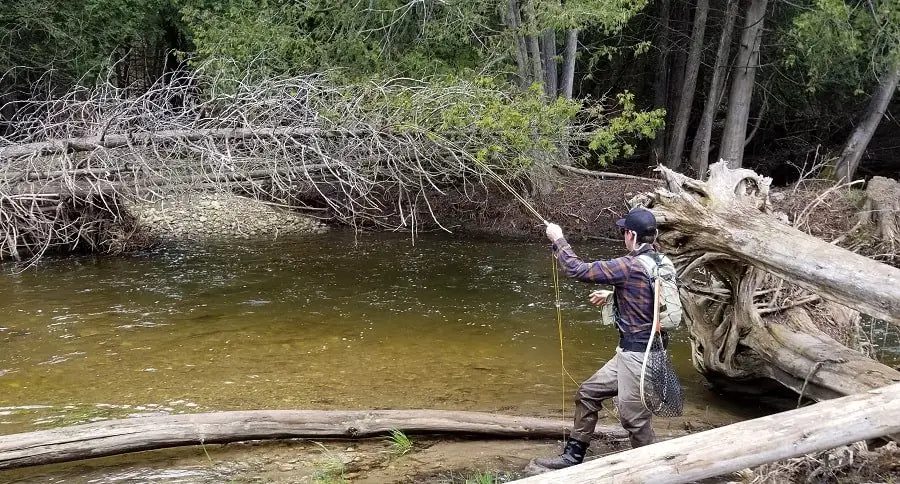
Want to know how to carry your fly fishing net or any wading net like a pro? Have you ever seen how professional tournament fly anglers and river guides attach their nets?
As a guide for over twenty years who has fished and trained with other experts, I know there are three good ways to attach and carry your wading net.
The three best ways to carry a fly fishing net:
- In a holster
- Hanging upside down on your back
- Hanging with the net up and handle down.
Each has its pros and cons, and in my opinion, based on experience, one of these is the best way and the way that many experts do it.
We may make a small commission from some of the links on this website, which is at no cost to you. I appreciate your support. Learn More
Wading Nets And Fly Fishing Nets
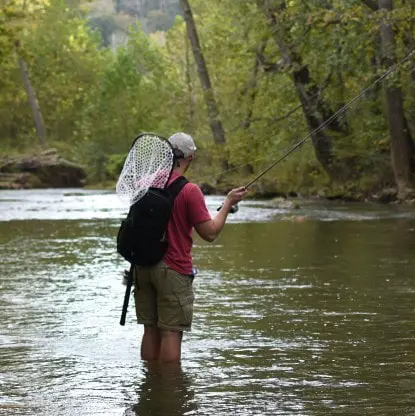
Smaller and lighter nets are best for river fishing because these nets allow you to carry your landing net on your body without needing to put it down at each spot or without it weighing you down.
Click here to see my recommendations for the best wading nets.
By keeping your net on you, you will never need to leave it behind on the bank when you go running after a big trout.
If the fish bolts down the river and your net is 50 feet behind you on the bank, it’s pretty much useless to you.
Hanging the net on your back is a great way to keep it up and out of the way while fishing, but it also keeps the net safe and prevents it from getting damaged or lost.
A Net Holster Is Good For Carrying A Wading Net
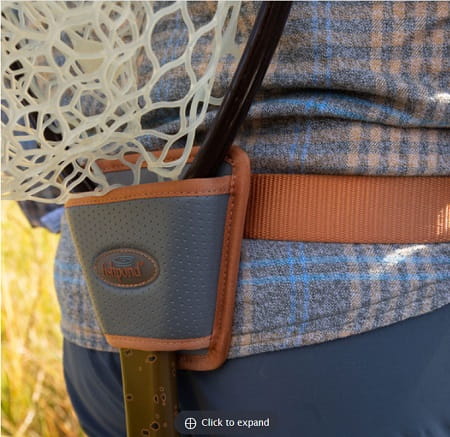
Using a net holster built into your fishing pack, your belt, or on your fly fishing pack vest is another way that works.
The FishPond Net Holster and the Smith Creek Net Holter can be added to your wading belt to secure your net in an upright position.
The good thing with this method is it keeps the mesh away from trees and branches that can dislodge or damage the net.
The downside to this way of carrying your wading net is that it can be tough to get the handle into your hand when one hand is on the rod fighting the fish. This is because in order to grab the net, you need to grab the net portion of the net and not the handle.
Once you grab the net and pull it, you need to somehow get the handle in your hand. If you gab the net as low as possible, which is at the top of the handle, it’s not too bad to slide it down and grab it lower on the handle.
Another downside to the holster is that long-handled nets can keep hitting the back of your legs. You may also find that if you have a lanyard hanging, it will catch on low-hanging branches.
Another belt attachment some anglers like is the Lively Legz Net Man Carrying System with a lanyard.
Hanging Your Net From Your Back: 2 Way
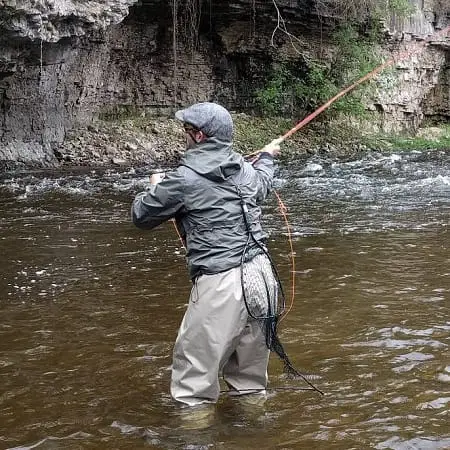
Hanging the net off a strong magnetic net release like the Orvis Magnetic Net Release is a good way to make it easy to grab your net when fighting a fish, but most anglers don’t use the best way.
The right way is how it is meant to be used; the best way often requires a modification, but it’s well worth the time to do it this way.
If you watch most trout anglers on the river, they will hang their nets from the handle off the back of their vest or off the back of their jacket.
The handle is up near their shoulders, and the net mesh is down near their lower back. The majority of river anglers do this because the trout nets they buy often come with a hole or a lanyard on the end of the handle, which is meant to attach to you. This sort of works, but there is a better way.
There are two problems with hanging your net off your back with the mesh down.
The first issue is that the mesh hoop hangs low down near your butt, and it swings back and forth when walking, which for me means the mesh is more likely to be catching on all the branches, and therefore I am more likely to get hung up or even rip the net.
This is the reason why I find so many nets on the ground or hanging off low tree branches. This is also why my net mesh rips all the time. When I hook a stump with that mesh as I’m walking, it can easily rip the net.
On some nets like the one in the above image, the net might even dangle in the river and can catch some floating debris.
The second reason not to hook up your net this way is that it’s common for the net handle, which is hung off the back of the jacket or a vest, to sag and hang low, putting that handle right between your shoulder blades where you can’t reach it easily when you are fighting that big fish.
This means that you probably need to reach low down near your butt and grab the hoop part of the net, then you have to juggle it with one hand until the handle part is in your hand properly, all while trying to manage your big fish with the other hand.
I see guys try to do this and drop the net in the water, which is not good if you are in fast water if your net is not secured with a lanyard.
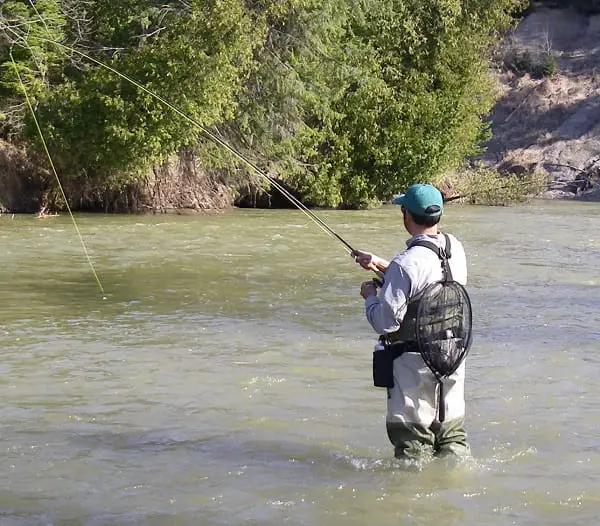
If you watch the competition fly anglers and some of the more experienced anglers, they have their nets hanging from the top of the hoop or even the side of the hoop and it’s connected to them up near their neck. I also do this.
By doing this, the handle is down near their butt, as you can see in the picture here.
The trout net also swings less this way, which means it hangs up less on branches, and it doesn’t catch debris unless you wade deep. This means the mesh net is less likely to rip or get dislodged and lost.
The best part about securing the net in this position is when I am fighting a fish, it’s very easy to reach around my lower back, grab the handle, have the net in the right-hand position, and be ready to net the fish fast!
This is how many professional competition fly anglers, guides, and more experienced anglers carry their net. You should do it this way too!
You can see how World champion competition anglers rig their nets hoop up and hoo sideways at Euro nymphing with the fly fishing world champion!
In this other video, you can see multiple competition anglers using all three ways of hanging a net, handle up, handle down, and handle sideways, check out World Fly Fishing Championship 2019.
You can see with the handle-up method that the net drags in the water a lot, and for me, it also hooks on far more branches in the bush.
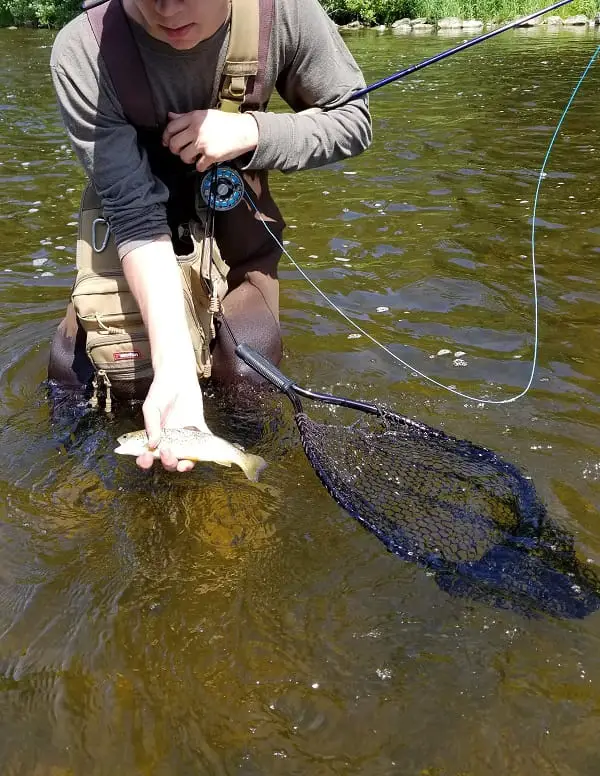
Guide Tip: Keep a long elastic-type lanyard on the handle and attach it to your belt. Attach the hoop end to the magnetic release.
If the trout net gets caught on a branch or something else and comes off the long rubber lanyard will eventually stop you in your tracks.
Being rubber and not rope, the elastic cord will prevent the net from ripping.
Secure Your Wading Net Properly
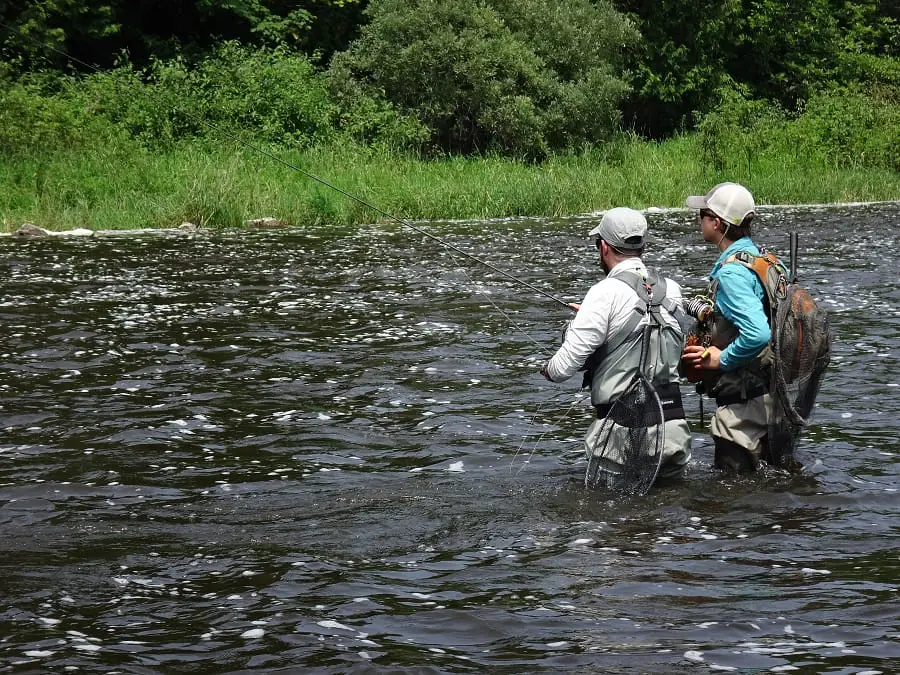
I have probably had my net catch on something and fall off my back without me noticing over twenty times in the last 35 years of fishing. In the early days, this meant I’d have to walk back a long way to find the net, or it meant me losing another net.
Once I started hooking up my net with a safety lanyard off the handle attached to my waist, with a 3-inch Aluminum Carabiner Clip, I stopped losing my wading nets. This extra step has saved me a lot of lost nets or time backtracking to find my net.
To hook your net up like a pro, you want to get yourself a strong trout net release magnet.
Then you want to secure a 3-inch aluminum Carabiner Clip to the end of the hoop on the net and then attach one end of the magnet there. The other end of the magnet will be attached to the back of your vest or jacket, or even the top of your wader straps.
Most vests and wading jackets and even the back of your chest waders will have a fabric hook to attach your net.
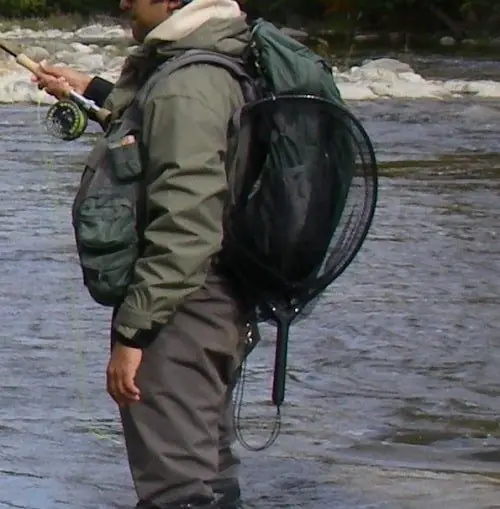
Once the magnetic release is secured on my back, I will then attach a stretchable cord or a lanyard to the end of the handle and the other end to my wader belt with a Carabiner. A great option for this is the Smith Creek Net Leash.
You can see this in the image of my buddy wading in the river.
The elastic cord should be long enough that if you need to reach out a full arm’s length, it will stretch that far. The elastic cord should be secured well so it won’t come off unless you unclip it. On some net handles, you may need to drill a hole or tape the cord onto the handle.
If the waist cord is secured properly, it will ensure that if my magnet net release lets go while I’m walking through the bush, it will still be attached by my waist, which will then pull me and notify me that it came off.
Without it, I might keep on walking. I have found plenty of nets along the path or floating down the river with only one end of the magnet attached. I’m on the river for over 300 days most years, so I’d bet that I find 3 to 5 nets every year.
This elastic safety cord also allows me to let go of my net while taking pictures or when releasing my fish, and my net won’t float away down the river.
If you don’t wear a vest or jacket, the other option is to hang the hoop part off a magnet and two carabiners off your wader belt and have a secondary elastic cord running from your trout net handle to your belt.
I hope I explained how to carry a fly fishing net or any type of wading net better. If you have any questions or tips, let us know in the comments section below.
Tight Lines,
Graham

I’ve been guiding for 13 years. I, and every guide I know carry their net with the handle down, and the net up, as shown in the picture (that says this is incorrect). Packs are designed to carry the nets this way. When you hold a net with a leash from your back it grabs trees and becomes untethered repeatedly. A holster doesn’t accommodate larger handle nets without the handle hitting your legs while you walk. In conclusion, the way you said is inconvenient, is the most widely used technique, and also the safest. This article seems to lack research, from a guide anyways. Note: it’s your net, carry it any way you like.
Hey Chris,
I forgot to mention that about the net hitting the back of your legs so I’ve updated it, thanks for pointing that out.
I’m not sure what you mean when you say “every guide I know carry their net with the handle down, and the net up, as shown in the picture (that says this is incorrect).” I agree with this and this is how I carry mine. it’s also how many competition anglers are now carrying there’s.
I don’t see any images that state that is incorrect, unless you mixed it up and you carry your net handle up and net down.
If you would like to see how some of the best competition anglers in the world hang their nets, check out Euronymphing with the fly fishing world champion! and World Fly Fishing Championship 2019.
The later video shows anglers using all three methods while the world champion hangs his net the same way I’ve been hanging mine for almost 10 years, however, all three methods work.
In the end, I have shown anglers multiple well-researched methods (Research = 37 years carrying nets up and down rivers + fishing with many experts) for hanging their nets and you and they can choose which one works best.
Regards,
Graham
Graham, I was glad I read this article. It just confirmed what I’ve always thought was the best way to carry my net, attached with a magnet at the top of my vest and the handle hanging down. After 50 plus years of fly fishing I’ve tried about every way to carry a net but I always come back to this way. I used a lumbar pack for a while but it had no way to attach the magnet thus no really good way to carry the net. Pretty much had to put the handle down in my wader belt and that didn’t work well at all. So went back to the reliable vest and all problems were fixed. So once again thanks for a great article on this!
Tight lines,
David Diefenderfer